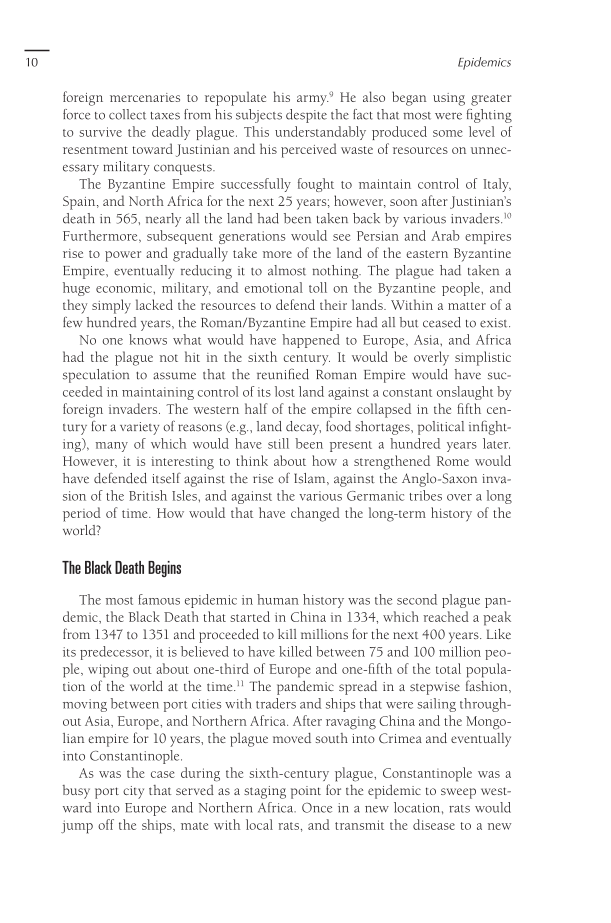10 Epidemics
foreign mercenaries to repopulate his army.9 He also began using greater
force to collect taxes from his subjects despite the fact that most were fighting
to survive the deadly plague. This understandably produced some level of
resentment toward Justinian and his perceived waste of resources on unnec-
essary military conquests.
The Byzantine Empire successfully fought to maintain control of Italy,
Spain, and North Africa for the next 25 years; however, soon after Justinian’s
death in 565, nearly all the land had been taken back by various invaders.10
Furthermore, subsequent generations would see Persian and Arab empires
rise to power and gradually take more of the land of the eastern Byzantine
Empire, eventually reducing it to almost nothing. The plague had taken a
huge economic, military, and emotional toll on the Byzantine people, and
they simply lacked the resources to defend their lands. Within a matter of a
few hundred years, the Roman/Byzantine Empire had all but ceased to exist.
No one knows what would have happened to Europe, Asia, and Africa
had the plague not hit in the sixth century. It would be overly simplistic
speculation to assume that the reunified Roman Empire would have suc-
ceeded in maintaining control of its lost land against a constant onslaught by
foreign invaders. The western half of the empire collapsed in the fifth cen-
tury for a variety of reasons (e.g., land decay, food shortages, political infight-
ing), many of which would have still been present a hundred years later.
However, it is interesting to think about how a strengthened Rome would
have defended itself against the rise of Islam, against the Anglo-Saxon inva-
sion of the British Isles, and against the various Germanic tribes over a long
period of time. How would that have changed the long-term history of the
world?
The Black Death Begins
The most famous epidemic in human history was the second plague pan-
demic, the Black Death that started in China in 1334, which reached a peak
from 1347 to 1351 and proceeded to kill millions for the next 400 years. Like
its predecessor, it is believed to have killed between 75 and 100 million peo-
ple, wiping out about one-third of Europe and one-fifth of the total popula-
tion of the world at the time.11 The pandemic spread in a stepwise fashion,
moving between port cities with traders and ships that were sailing through-
out Asia, Europe, and Northern Africa. After ravaging China and the Mongo-
lian empire for 10 years, the plague moved south into Crimea and eventually
into Constantinople.
As was the case during the sixth-century plague, Constantinople was a
busy port city that served as a staging point for the epidemic to sweep west-
ward into Europe and Northern Africa. Once in a new location, rats would
jump off the ships, mate with local rats, and transmit the disease to a new
















































































































































































































































































































































